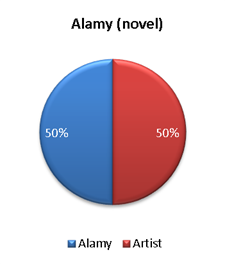Alamy Images has cemented its place as a top choice for photographers and buyers alike. It’s an online platform that specializes in high-quality stock images, offering a treasure trove of visuals for diverse needs. Whether you're a creative professional working on a project or a brand looking for that perfect photo, Alamy makes it easy to find images that resonate. In this post, we’ll dive into how
Factors Influencing Alamy Image Pricing

When it comes to pricing images on Alamy, it’s essential to recognize that multiple elements play a role. Knowing these factors can help you make more informed decisions, whether you're a buyer or a contributor. Let’s break down some of the key aspects:
- License Type: Alamy offers several licensing options—royalty-free, rights-managed, and extended licenses. Each option comes with different price tags and functionality. For example, royalty-free images allow unlimited use for a one-time fee, while rights-managed images may charge based on usage, duration, and geographical distribution.
- Image Size and Quality: Larger and higher-resolution images often come with a higher price due to their increased production value and versatility. Think about it—if you need a stunning piece for a billboard, the image size and quality become crucial.
- Contributor Reputation: Well-known photographers or contributors with a good track record might charge more for their images because of their established experience and the trust they’ve built over time. Buyers may feel more comfortable investing in visuals from seasoned professionals.
- Market Demand: Just like any marketplace, the demand for certain types of images can influence pricing. For instance, images reflecting current trends, seasonal events, or popular themes might command higher prices during peak times.
- Exclusivity: If an image is exclusive to Alamy or a specific photographer, it may be priced higher. Exclusive images often draw interest because they can provide unique visual content that stands out in a saturated market.
- Location and Subject Matter: The context of an image can also affect its price. For example, stunning landscapes from exotic locations or culturally rich subjects may be priced higher than more common or generic images.
In summary, several factors come into play when it comes to Alamy’s image pricing. Understanding the interplay between license type, image quality, contributor reputation, market demand, exclusivity, and subject matter can help you navigate this dynamic marketplace like a pro. Whether you’re looking to buy images for your next project or considering contributing your work, being aware of these influences can significantly impact your experience on Alamy.
Also Read This: Comparing Pricing and Licensing Options for Imago Images and Its Competitors
3. Understanding Alamy's Royalty Structure

When navigating the fascinating world of stock photography, one of the key aspects to grasp is the royalty structure. Alamy, a popular platform for photographers and buyers alike, has a unique approach that sets it apart from many of its competitors. Let's dive deeper into how their royalty system works and what it means for you as a contributor or a buyer.
Alamy offers one of the most photographer-friendly royalty structures in the stock image industry. Unlike many platforms that operate on a tiered system, Alamy offers a straightforward royalty rate based primarily on the image price agreed upon during the sale. Here's how it breaks down:
- 70% Royalty Rate: As a contributor, you receive a massive 50-60% of the net sale depending on the type of license sold. But it gets even better; if your image prices are set higher, your cut can reach up to 70%!
- Types of Licenses: Alamy uses various licenses such as standard, enhanced, and exclusive, each providing different percentages based on how the image will be used. Enhanced licenses, which offer broader usage rights, effectively generate more revenue for both you and Alamy.
- Pricing Flexibility: Photographers can set their prices according to the type of images they are selling, which means if you have exceptional or niche content, you can price it at a premium.
Moreover, Alamy's transparent pricing means there are no hidden costs, allowing you to know precisely what you're earning. Unlike other platforms that might cut into your earnings with various fees or charges, Alamy focuses on straightforward calculations and maximizes the income potential for its contributors. Remember, the higher the image sells for, the more you earn! This clear structure encourages photographers to push quality content, knowing they will receive a fair share of the sale.
Also, it's essential to understand that your royalties may vary based on how the buyer uses the image. For example, if you sell an enhanced license, you may earn a more considerable portion than a standard usage. The key takeaway is that Alamy's royalty structure rewards quality and provides clear rewards for impactful content.
Also Read This: Blocking Alamy Results on Google Search
4. Comparing Alamy Prices with Other Stock Image Platforms
When it comes to stock photography, price can be a significant deciding factor for both buyers and photographers. Alamy boasts a different pricing model compared to other platforms equipped with subscription models or bulk purchasing options. So, how does Alamy stack up against these competitors? Let’s break it down!
1. Price Points: Alamy's image prices range quite widely based on several factors, including the image's exclusivity and quality. Generally, a standard price for a typical image starts at around $19, going up to several hundred dollars for premium content. This model contrasts with sites like Shutterstock or Adobe Stock, where buyers often pay a monthly fee for access to a library of images.
2. Quality vs. Quantity: While stock platforms like Getty Images might offer lower prices for mass selections, Alamy focuses heavily on quality. As a contributor, you're not competing on price alone but instead showcasing your unique photography. Alamy hosts fewer images than giants like Shutterstock but promotes a more curated selection, allowing buyers to find unique and high-quality visuals.
3. Exclusive Vs. Non-Exclusive: Alamy permits non-exclusive agreements meaning photographers can sell the same images on multiple platforms. This feature can lead to a broader array of pricing strategies for photographers since they can test out various pricing models across platforms.
4. Simple Licensing: When you consider pricing, it's also crucial to look at licensing simplicity. Alamy's robust yet easy-to-understand licensing terms can save buyers time and hassle, making it an attractive choice for many looking to procure images.
In conclusion, while Alamy may not always compete on the low-price front, the platform clearly offers substantial benefits for photographers and buyers alike through its focus on quality, transparent royalty structures, and flexible pricing strategies. If you're considering where to license or sell your photographic work, examining Alamy in tandem with other stock image platforms can give you a comprehensive outlook on the industry's offerings.
Also Read This: Does 123RF Offer a Free Trial? Exploring Options to Access the Platform
5. Tips for Maximizing Your Earnings on Alamy
If you're looking to make the most out of your experience on Alamy, there are several strategies you can implement to boost your earnings. Alamy’s platform is a goldmine for photographers and content creators, but creating great images isn’t always enough. Here are some tips to help you maximize your income:
- Focus on Quality, Not Quantity: It's tempting to upload as many images as possible, but quality reigns supreme. Invest time in crafting stunning, high-resolution images that tell a story or evoke emotions. Unique and well-composed photographs tend to attract more buyers.
- Optimize for Keywords: When you upload your images, make sure to use relevant keywords that accurately describe the content. Think about what potential buyers might search for. The better your metadata, the easier it is for your images to be discovered.
- Diversify Your Portfolio: Different clients look for varied styles and subjects. It’s smart to diversify your offerings by photographing a mix of landscapes, portraits, and macro shots. This approach allows you to cater to a broader audience.
- Stay Current with Trends: Keep an eye on industry trends and seasonal demands. For instance, images related to holidays or significant events can have a spike in demand. By understanding what’s popular, you can tailor your uploads accordingly.
- Engage with the Community: Don’t underestimate the power of networking. Engage with other photographers and potential buyers on Alamy’s forums or social media platforms. Building connections can lead to collaborations and increased visibility.
- Stay Consistent: The more regularly you upload new content, the more chances you have for sales. Set a schedule to upload a certain number of images per week or month. Consistency can help keep your portfolio fresh and engaging.
Implementing these tips can significantly improve your chances of racking up those sales. Always remember that perseverance pays off; stay dedicated, keep learning, and adapt your strategies as needed!
6. Conclusion: Navigating Alamy's Pricing and Royalties
Navigating the world of image pricing and royalties can be both daunting and rewarding, especially on platforms like Alamy. Understanding how their pricing structure works and how royalties are calculated is crucial for photographers and creators who want to thrive.
Alamy operates on a simple yet effective pricing model. When someone purchases your image, you earn a percentage of the sale—typically ranging between 25% to 50% of the net sale price, depending on the exclusivity and licensing type. This compensation model can be highly beneficial for contributors who consistently deliver quality content and capitalize on demand trends.
In addition, Alamy's approach to pricing is grounded in transparency. You can see how much you will earn on each sale, allowing you to make informed decisions when pricing your images. Keeping your portfolio up to date with fresh content and actively engaging with potential buyers can lead to more successful sales.
Remember: patience is key. Earnings might not flood in initially, but as you build your portfolio, refine your skills, and adapt your strategies, your potential for success increases. With perseverance and a keen understanding of Alamy's ecosystem—pricing and royalties included—you can turn your passion for photography into a profitable venture. So, go ahead and start snapping those photos, because your next sale is just a click away!
 admin
admin








